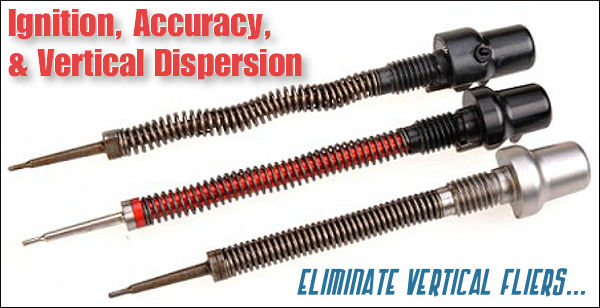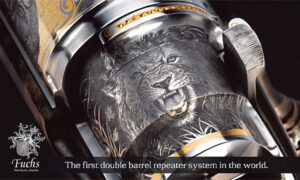Top to bottom: Remington short-action firing pin assembly with ISS. Tubb SpeedLock alloy composite system without ISS. The U.S. Army Marksmanship Unit publishes regular technical articles on its Facebook page. One USAMU article discussed mechanical issues and ignition irregularities which can cause vertical fliers, even with good ammunition. This article offers some very important tech tips. Vertical Dispersion – Mechanical/Ignition Problems? It has been long known that poor or inconsistent ignition is one of the “usual” suspects when vertical fliers are observed. By understanding the basics and knowing where to look, the shooter can avoid a lot of frustration, time, and expensive loading components. Are you experiencing vertical fliers on your high-quality rifle with more than one handload combination? Consider the bedding, crown, and scope/sight mountings. Are they correct or not? If they are, you should check for ignition problems before embarking on an expensive and possibly fruitless search for the “magic load”. SEEING IS BEING BELIEVING. Although the author was aware of the importance of a good ignition when dealing with vertical flyers in an otherwise excellent rifle, seeing the problem and its almost immediate cure really brought the lesson home. He was using a.22 LR “dot” match rifle, which stacked bullets in little piles out to 50 yards and beyond. One lot of ELEY Tenex produced consistent “bugholes” groups at 50 yards, but another, selected, lot of Tenex would regularly ruin similar groups by single vertical fliers, which did not occur in other rifles. He didn’t want to spend days burning expensive ammunition in search of “magic loads” so he called a respected rimfire gunsmith. The highly-experienced gunsmith ripped into the rifle action and found the problem without batting an eyebrow. He found a firing pin spring that was clearly weak, as well as a chip on the firing pin’s face where it touched the cartridge rim. After replacing the offending parts and tuning them, the rifle began to shoot tiny, bughole-shaped groups with the “unacceptable”, previously lot of Tenex. Positive, consistent ignition is also beneficial for centerfire rifles. A riflesmith who is knowledgeable and experienced is worth his weight in Gold! What are some things we can check in our rifles as shooters to determine if the ignition problem is part of our issue? Ask yourself at the club level if you are still using that 40-80-year-old factory striker in your “experienced” Remington 70, Winchester 70 or Springfield match bolt gun. A new striker spring is a cheap way to protect yourself from current or future problems. (And BTW, you might want to stick with the factory-spec spring. A spring that is too powerful can cause vertical just as much as one that is too weak. A quick and easy way to eliminate potential problems is to check the firing-pin protrusion. The centering of the firing-pin in the bolt and its consistency are also important factors to consider. This is less of an issue with the increased use of precision-machined actions. Below is a firing pin assembly from a BAT custom action: With factory actions, it is easy to check the firing tip by removing the bolt and letting the firing rod advance. Is the firing pin tip off-center and possibly hitting it as it moves? Is the hole rounded or burred because it has been repeatedly struck? A trip to the riflesmith may be in order if this is the case. Similar machining issues can cause erratic and rough firing pin movement. The firing pin may drag against the internal surface of the barrel. These issues are not uncommon, but they are rare in high-quality rifles. They can be ruled out within minutes. You may want to remove the cocking pin/firing spring assembly and check for unusual gouges, dings or wear. This task is particularly easy with Winchester 70s and Springfields. It only requires the push of a single button and the removal of the cocking assembly. It is for this reason that these tried-and true actions have such a loyal fan base in the field among hunters who are unable to maintain their rifles at a shop. Watch for and remove any excess grease, or even Cosmoline! Both the firing pin assembly as well as the inside of the bolt should be cleaned to remove any excess grease (or even Cosmoline!) This can improve the firing pin speed and consistency. Other bolt-action designs might require a take-down device or other measures. As part of the inspection, after ensuring that the rifle is unloaded, slowly cock it, dry-fire and repeat severally. Listen closely near the action to check for any inconsistent sounds. Does the striker fall make the same noise every time? Do you feel or hear grinding when the machine is operated? If so, what is the location? Check the operation of the cocking-piece (bolt shroud), the firing pin within the shroud of the bolt, the cocking-piece cam and the rear part of the bolt where the cam operates. Look for marks that indicate roughness or the need for a light polishing. While you’re at the bearing surfaces, clean them and lightly grease them. Remington 700 bolt shroud, cocking cam
Shooters can perform these checks on their own. Other mechanical issues, primarily centered around the action and spring of the sear, trigger, or sear spring, can also cause ignition problems. If you suspect these issues, it is best to consult an experienced and qualified riflesmith. We hope this information is helpful. Enjoy the shooting sports and join us next week!

















